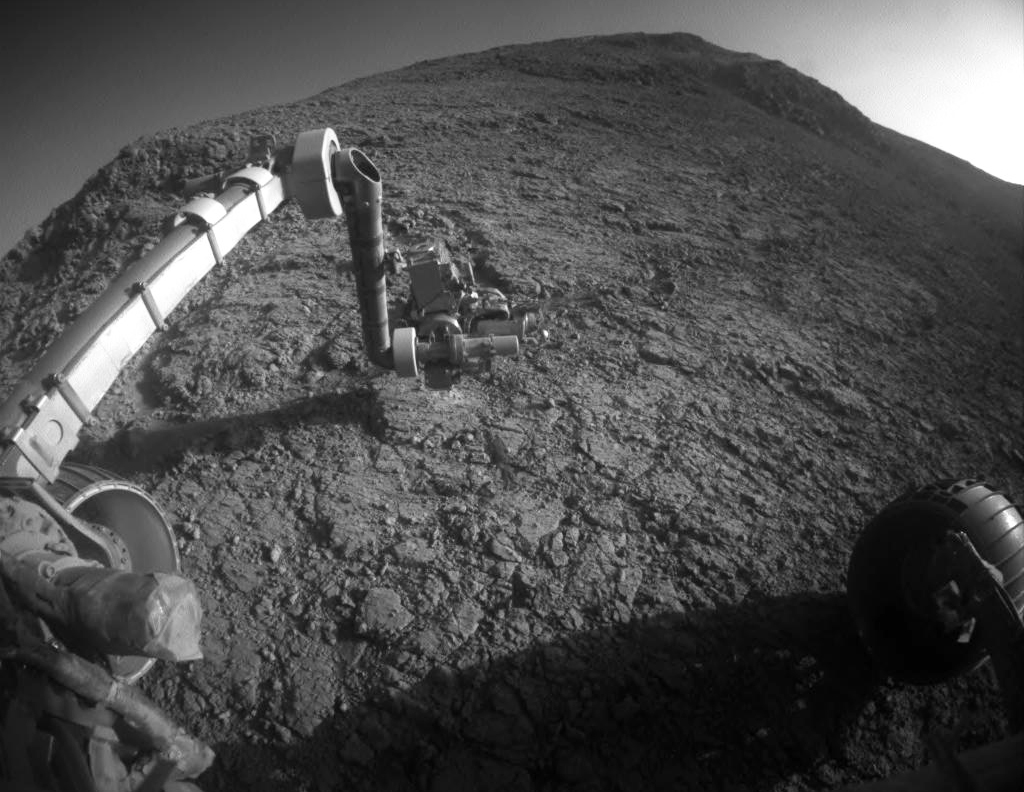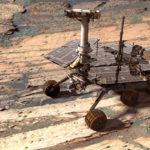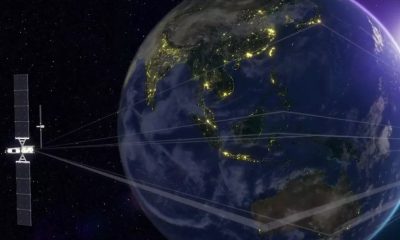

News
NASA officially says goodbye to Mars Opportunity rover lost in massive dust storm
After 15 years roving around our neighboring red planet, NASA announced the end of its Opportunity rover mission on Mars today during a live conference held at 2 pm EST. The rover’s team of scientists spent last night sending a set of commands intended to be the last attempt at waking Opportunity, and this afternoon’s announcement confirmed the final fate of the mission. A planet-wide dust storm in summer of 2018 shut the Martian rover down due to its solar panels being blocked from debris, and the long duration spent without power apparently led to a series of failures which prevented a recovery. The last communication NASA received from Opportunity was on June 10, 2018.
#OppyPhoneHome Update
Tonight, we’ll make our last planned attempts to contact Opportunity. The solar-powered rover last communicated on June 10, 2018, as a planet-wide dust storm swept across Mars.
Want to show the team some love? Send a postcard: https://t.co/eO2SClFcYm pic.twitter.com/trDjRNf65E
— NASA Mars (@NASAMars) February 12, 2019
Over the last few months, while scientists continued to revive Opportunity, hopes were fairly high that communication would be reestablished. The rover’s batteries were in good health prior to the dust storm, and the surface temperature was relatively warm when the storm began. Also, its programming was designed with “fault modes” allowing actions to be taken automatically to maintain the rover’s health. The team at NASA had attempted to talk to Opportunity several times per week once the storm began to clear using the Deep Space Network, an international array of giant radio antennas supporting interplanetary spacecraft missions, and over 600 attempts were made without any response received. The announcement was broadcast live via NASA’s website.
Emotions were high during NASA’s mission end announcement. Associate NASA Administrator Thomas Zurbuchen began the event’s commentary: “I stand here, surrounded by the team…it’s an emotional time,” he began. “Science is a team sport, and that’s what we’re celebrating today.” NASA Administrator Jim Bridenstine noted that while Opportunity stopped communicating around the same time be began his service with the administration, he was still in awe at the achievements the rover and its team were able to achieve throughout their mission. “When this little rover landed, the objective was to have it move 1100 yards and survive for 90 days,” he exclaimed before reiterating the unexpected 15 years the mission eventually lasted. Michael Watkins, Director of NASA’s Jet Propulsion Laboratory commented on the mission’s broader contribution to society: “Spirit and Opportunity energized the public about the spirit of Mars exploration.”
John Callas, project manager of NASA’s Mars Exploration Rover (MER) project, provided some insight about what could have caused Opportunity to shut down for good. Earlier in Opportunity’s mission days, a heater on its robotic arm failed to turn off, draining the rover’s energy in the process. To overcome this issue, the team at NASA designed a deep sleep mode which shut down nearly everything on Opportunity, including the heater. Callas surmised that the dust storm which ended the rover’s mission may have disrupted its sleep cycle, reinstating the power draining issue and preventing recovery. He also described the quality of Opportunity’s batteries and the seasonal reliability of the Martian winds to clean its solar panels as part of the reasons it lasted as long as it did. Finally, Callas had his own farewell comments to add. “Even though it’s a machine, saying goodbye, it’s very hard and very poignant,” he remarked.
- NASAs Mars Curiosity Rover takes a selfie in the middle of a massive storm. [Credit: Seán Doran/Flickr]
- InSight, a NASA mission to put another spacecraft on Mars, is the first mission dedicated to investigating the deep interior of Mars. The findings will advance understanding of how all rocky planets, including Earth, formed and evolved. Source: NASA/JPL-Caltech
NASA’s Opportunity rover (nicknamed “Oppy”) launched on July 7, 2003, aboard a Delta II rocket from Cape Canaveral, Florida. Its primary mission was to search for and characterize rocks and soil while looking for indications of water activity in the Martian past. One of the better-known discoveries made by the rover was the discovery of hematite on the surface, a mineral which typically forms in water. Also found were strips of gypsum in rocks around a crater, indicating that water most likely flowed through the area at one point. The storm which finally ended the rover’s mission was intense and massive, its size is roughly the area of North America and Russia combined with Opportunity in the center.
A month prior to Opportunity’s launch, its twin rover Spirit headed for Mars with a similar mission. Both rovers lasted years longer than their 90-day expected life span, but unfortunately, Spirit’s mission ended before Opportunity’s when it became lodged in soft soil at a site called “Troy”. NASA ended its rescue effort of Spirit in May 2011. Another NASA rover named Curiosity is still crawling the planet, however. Its plutonium-nuclear power source helped it avoid the same fate that came over its predecessor, even sending back a storm-riding selfie during the event that claimed Opportunity.
NASA’s most recent mission to Mars was its InSight lander, a geological science mission sent to study the core of the planet and atmosphere. After arriving at the red planet in late November 2018 with twin CubeSat mission MarCo, it successfully landed without incident and sent a dusty photo back for Earthling enjoyment and arrival confirmation. In the months since it’s treated NASA and the public alike with selfies and the sound of Martian wind. Its instruments have recently been placed on the surface, so new planet data is expected soon.
Up next for the fourth rock from the Sun will be Mars 2020, an advanced rover dedicated to high-priority science missions including the search for habitable conditions and microbes in the ancient past. NASA plans to launch this rover in July 2020.
News
Tesla begins Robotaxi certification push in Arizona: report
Tesla seems serious about expanding its Robotaxi service to several states in the coming months.

Tesla has initiated discussions with Arizona transportation regulators to certify its driverless Robotaxi service in the state, as per a recent report from Bloomberg News. The move follows Tesla’s launch of its Robotaxi pilot program in Austin, Texas, as well as CEO Elon Musk’s recent comments about the service’s expansion in the Bay Area.
The Arizona Department of Transportation confirmed to Bloomberg that Tesla has reached out to begin the certification process for autonomous ride-sharing operations in the state. While details remain limited, the outreach suggests that Tesla is serious about expanding its driverless Robotaxi service to several territories in the coming months.
The Arizona development comes as Tesla prepares to expand its service area in Austin this weekend, as per CEO Elon Musk in a post on X. Musk also stated that Tesla is targeting the San Francisco Bay Area as its next major market, with a potential launch “in a month or two,” pending regulatory approvals.
Tesla first launched its autonomous ride-hailing program on June 22 in Austin with a small fleet of Model Y vehicles, accompanied by a Tesla employee in the passenger seat to monitor safety. While still classified as a test, Musk has said the program will expand to about 1,000 vehicles in the coming months. Tesla will later upgrade its Robotaxi fleet with the Cyercab, a two-seater that is designed without a steering wheel.
Sightings of Cybercab castings around the Giga Texas complex suggests that Tesla may be ramping the initial trial production of the self-driving two-seater. Tesla, for its part, has noted in the past that volume production of the Cybercab is expected to start sometime next year.
In California, Tesla has already applied for a transportation charter-party carrier permit from the state’s Public Utilities Commission. The company is reportedly taking a phased approach to operating in California, with the Robotaxi service starting with pre-arranged rides for employees in vehicles with safety drivers.
News
Tesla sets November 6 date for 2025 Annual Shareholder Meeting
The automaker announced the date on Thursday in a Form 8-K.

Tesla has scheduled its 2025 annual shareholder meeting for November 6, addressing investor concerns that the company was nearing a legal deadline to hold the event.
The automaker announced the date on Thursday in a Form 8-K submitted to the United States Securities and Exchange Commission (SEC). The company also listed a new proposal submission deadline of July 31 for items to be included in the proxy statement.
Tesla’s announcement followed calls from a group of 27 shareholders, including the leaders of large public pension funds, which urged Tesla’s board to formally set the meeting date, as noted in a report from The Wall Street Journal.
The group noted that under Texas law, where Tesla is now incorporated, companies must hold annual meetings within 13 months of the last one if requested by shareholders. Tesla’s previous annual shareholder meeting was held on June 13, 2024, which placed the July 13 deadline in focus.
Tesla originally stated in its 2024 annual report that it would file its proxy statement by the end of April. However, an amended filing on April 30 indicated that the Board of Directors had not yet finalized a meeting date, at least at the time.
The April filing also confirmed that Tesla’s board had formed a special committee to evaluate certain matters related to CEO Elon Musk’s compensation plan. Musk’s CEO performance award remains at the center of a lengthy legal dispute in Delaware, Tesla’s former state of incorporation.
Due to the aftermath of Musk’s legal dispute about his compensation plan in Delaware, he has not been paid for his work at Tesla for several years. Musk, for his part, has noted that he is more concerned about his voting stake in Tesla than his actual salary.
At last year’s annual meeting, TSLA shareholders voted to reapprove Elon Musk’s compensation plan and ratified Tesla’s decision to relocate its legal domicile from Delaware to Texas.
Elon Musk
Grok coming to Tesla vehicles next week “at the latest:” Elon Musk
Grok’s rollout to Tesla vehicles is expected to begin next week at the latest.

Elon Musk announced on Thursday that Grok, the large language model developed by his startup xAI, will soon be available in Tesla vehicles. Grok’s rollout to Tesla vehicles is expected to begin next week at the latest, further deepening the ties between the two Elon Musk-led companies.
Tesla–xAI synergy
Musk confirmed the news on X shortly after livestreaming the release of Grok 4, xAI’s latest large language model. “Grok is coming to Tesla vehicles very soon. Next week at the latest,” Musk wrote in a post on social media platform X.
During the livestream, Musk and several members of the xAI team highlighted several upgrades to Grok 4’s voice capabilities and performance metrics, positioning the LLM as competitive with top-tier models from OpenAI and Google.
The in-vehicle integration of Grok marks a new chapter in Tesla’s AI development. While Tesla has long relied on in-house systems for autonomous driving and energy optimization, Grok’s integration would introduce conversational AI directly into its vehicles’ user experience. This integration could potentially improve customer interaction inside Tesla vehicles.
xAI and Tesla’s collaborative footprint
Grok’s upcoming rollout to Tesla vehicles adds to a growing business relationship between Tesla and xAI. Earlier this year, Tesla disclosed that it generated $198.3 million in revenue from commercial, consulting, and support agreements with xAI, as noted in a report from Bloomberg News. A large portion of that amount, however, came from the sale of Megapack energy storage systems to the artificial intelligence startup.
In July 2023, Musk polled X users about whether Tesla should invest $5 billion in xAI. While no formal investment has been made so far, 68% of poll participants voted yes, and Musk has since stated that the idea would be discussed with Tesla’s board.
-

 Elon Musk1 week ago
Elon Musk1 week agoTesla investors will be shocked by Jim Cramer’s latest assessment
-

 Elon Musk3 days ago
Elon Musk3 days agoElon Musk confirms Grok 4 launch on July 9 with livestream event
-

 Elon Musk15 hours ago
Elon Musk15 hours agoxAI launches Grok 4 with new $300/month SuperGrok Heavy subscription
-

 News7 days ago
News7 days agoTesla Model 3 ranks as the safest new car in Europe for 2025, per Euro NCAP tests
-

 Elon Musk2 weeks ago
Elon Musk2 weeks agoA Tesla just delivered itself to a customer autonomously, Elon Musk confirms
-

 Elon Musk1 week ago
Elon Musk1 week agoxAI’s Memphis data center receives air permit despite community criticism
-

 Elon Musk2 weeks ago
Elon Musk2 weeks agoTesla’s Omead Afshar, known as Elon Musk’s right-hand man, leaves company: reports
-

 News2 weeks ago
News2 weeks agoXiaomi CEO congratulates Tesla on first FSD delivery: “We have to continue learning!”





















